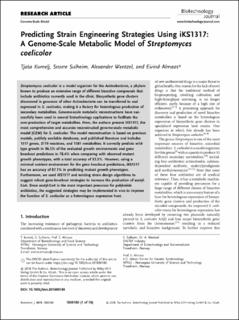| dc.contributor.author | Kumelj, Tjasa | |
| dc.contributor.author | Sulheim, Snorre | |
| dc.contributor.author | Wentzel, Alexander | |
| dc.contributor.author | Almaas, Eivind | |
| dc.date.accessioned | 2020-12-30T11:06:47Z | |
| dc.date.available | 2020-12-30T11:06:47Z | |
| dc.date.created | 2019-01-14T09:23:48Z | |
| dc.date.issued | 2018 | |
| dc.identifier.citation | Biotechnology Journal. 2018, . | en_US |
| dc.identifier.issn | 1860-6768 | |
| dc.identifier.uri | https://hdl.handle.net/11250/2721111 | |
| dc.description.abstract | Streptomyces coelicolor is a model organism for the Actinobacteria, a phylum known to produce an extensive range of different bioactive compounds that include antibiotics currently used in the clinic. Biosynthetic gene clusters discovered in genomes of other Actinobacteria can be transferred to and expressed in S. coelicolor, making it a factory for heterologous production of secondary metabolites. Genome‐scale metabolic reconstructions have successfully been used in several biotechnology applications to facilitate the over‐production of target metabolites. Here, the authors present iKS1317, the most comprehensive and accurate reconstructed genome‐scale metabolic model (GEM) for S. coelicolor. The model reconstruction is based on previous models, publicly available databases, and published literature and includes 1317 genes, 2119 reactions, and 1581 metabolites. It correctly predicts wild‐type growth in 96.5% of the evaluated growth environments and gene knockout predictions in 78.4% when comparing with observed mutant growth phenotypes, with a total accuracy of 83.3%. However, using a minimal nutrient environment for the gene knockout predictions, iKS1317 has an accuracy of 87.1% in predicting mutant growth phenotypes. Furthermore, we used iKS1317 and existing strain design algorithms to suggest robust gene‐knockout strategies to increase the production of acetyl‐CoA. Since acetyl‐CoA is the most important precursor for polyketide antibiotics, the suggested strategies may be implemented in vivo to improve the function of S. coelicolor as a heterologous expression host. | en_US |
| dc.language.iso | eng | en_US |
| dc.publisher | Wiley | en_US |
| dc.rights | Navngivelse 4.0 Internasjonal | * |
| dc.rights.uri | http://creativecommons.org/licenses/by/4.0/deed.no | * |
| dc.subject | Streptomyces coelicolor | en_US |
| dc.subject | genome‐scale model | en_US |
| dc.subject | constraint‐based optimization | en_US |
| dc.title | Predicting strain engineering strategies using iKS1317: a genome-scale metabolic model of Streptomyces coelicolor | en_US |
| dc.type | Peer reviewed | en_US |
| dc.type | Journal article | en_US |
| dc.description.version | publishedVersion | en_US |
| dc.rights.holder | © 2018 The Authors. Biotechnology Journal Published by Wiley-VCH Verlag GmbH & Co. KGaA.. This is an open access article under the terms of the Creative Commons Attribution License, which permits use, distribution and reproduction in any medium, provided the original work is properly cited. | en_US |
| dc.source.pagenumber | 10 | en_US |
| dc.source.volume | 14 | en_US |
| dc.source.journal | Biotechnology Journal | en_US |
| dc.source.issue | 4 | en_US |
| dc.identifier.doi | 10.1002/biot.201800180 | |
| dc.identifier.cristin | 1655826 | |
| dc.relation.project | Norges forskningsråd: 248885 | en_US |
| dc.source.articlenumber | 1800180 | en_US |
| cristin.unitcode | 7401,80,1,0 | |
| cristin.unitname | Bioteknologi og nanomedisin | |
| cristin.ispublished | true | |
| cristin.fulltext | original | |
| cristin.qualitycode | 1 | |

